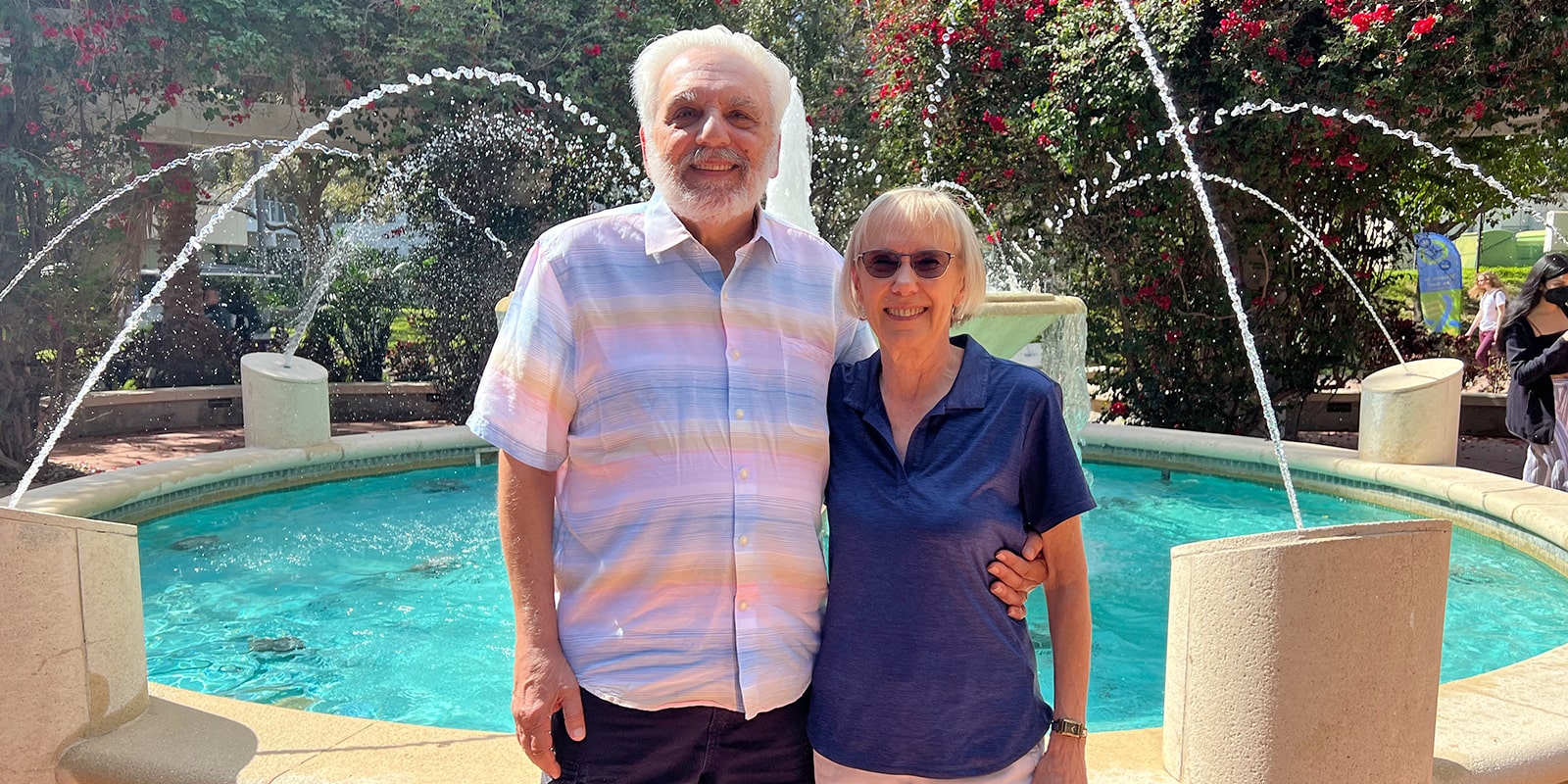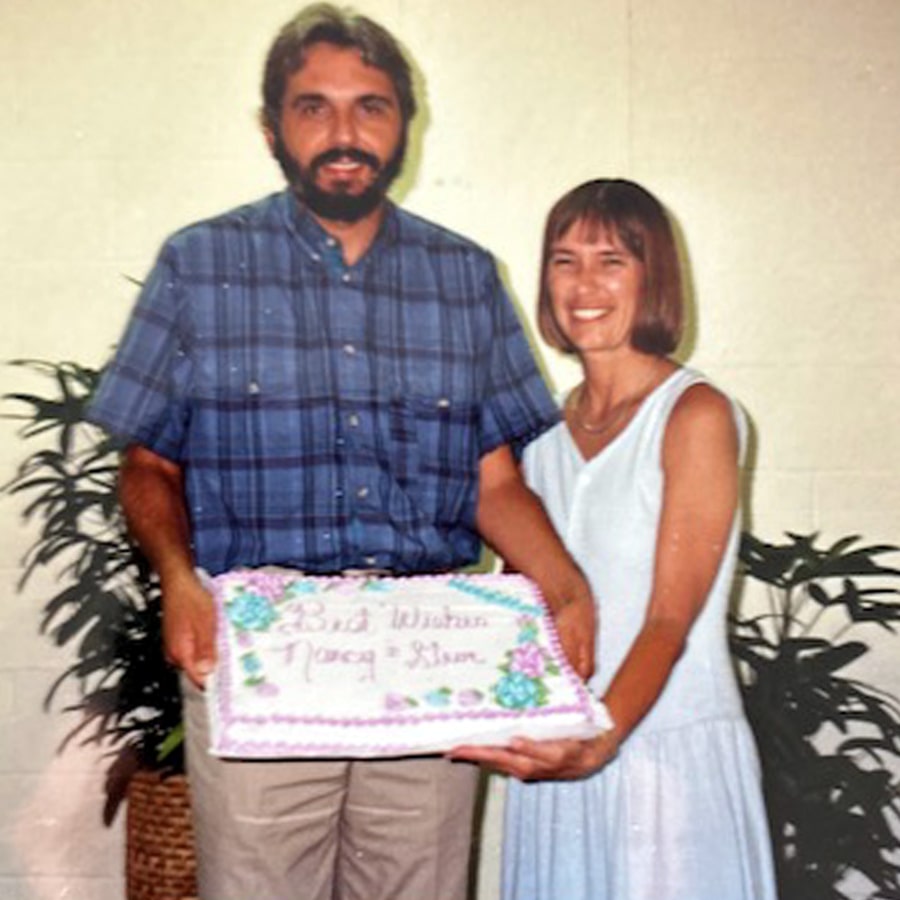
Two pioneering retired professors reconnect with USF — and support history students with a new scholarship
April 21, 2023
Their engaging textbook entwines voices that shaped the nation. But at this particular moment, amid the lunch-hour clatter of a USF St. Petersburg campus pub, the voices belong to the authors – retired professors Nancy Hewitt and Steven Lawson – who are busy exploring how they long ago helped shape the course of the university’s history department.
It is a narrative of how a small staff grew and came of age in the 1970s and ’80s. It is a love story. And now, in a most recent turn, it is a tale of giving back.
Here’s how this history lesson with Lawson, an authority on the Civil Rights movement, and Hewitt, a women’s studies scholar, unfolded – and led to the couple endowing a history scholarship in the College of Arts & Sciences.
“My first job after completing my PhD at Columbia University was in 1972, when I came down to teach at USF St. Petersburg,” Lawson says. “The campus had just opened seven years earlier, so you could say I was one of the pioneers. I can tell you it was a great culture shock coming from New York City.”
Back then, as Lawson recalls, the university only had a small history department, based on the Tampa campus. A handful of professors taught courses both in Tampa and the small St. Petersburg campus.
“I happened to see an ad in a historical newsletter in New York about a job at the University of South Florida, St. Petersburg,” said Lawson. “I’d never heard of USF. But I knew St. Petersburg, because I was a Yankees fan and they trained there.”
Without many other options, he applied and got the job, residing in Tampa where most of his History Department colleagues lived.
“I questioned whether this is what I really wanted to do,” he remembers. “I was mostly teaching young men my own age, many of whom had fought in Vietnam while I had student deferments. But I came to like it.”
It wasn’t just the professional side he found fulfilling – teaching predominantly on the St. Petersburg campus from 1972-78, before transferring to Tampa to become chair of the History Department, which was comprised of about a dozen male instructors.
It had to do with the arrival in 1980 of the department’s first female instructor, Nancy Hewitt, an impressive women’s historian from the University of Pennsylvania. Hewitt was thrilled to take a professional step forward, landing her first full-time job and joining the ranks of USF’s budding history staff.
From a personal perspective, a big change was in store for both.
• • •
At the time, Women’s Studies was an up-and-coming field, and Hewitt’s scholarship in the subject helped her land a part-time fellowship at Penn.
A Rochester native, she completed her undergraduate studies at the State University of New York-Brockport, and began her Penn fellowship in 1975 on a staff that included renowned women’s historian Carroll Smith-Rosenberg. Unfortunately, Rosenberg was on leave for two years, but Hewitt took courses and loved working as a teaching assistant. She began her job search in 1980 while completing her dissertation.
“The job market wasn’t great, but one of the things many schools were looking for were women history professors,” she says. “That was the case at USF.”
Hewitt recalls that there were nine such women’s history jobs in the country at the time, virtually all at state universities. She attended an American Historical Association meeting in December 1980, where she met with one hiring committee after the next.
“I did all nine interviews. And I loved that USF’s was the friendliest and least stressful,” Hewitt says. “My focus was women’s activism in the 19th century and they seemed genuinely interested.”
Lawson was not on the interview team that invited her to campus for the next round, nor did he see her campus interview. But he was asked to take her to a few meetings with faculty members known to be difficult. He was impressed by how she handled herself, as was everyone else, and Hewitt was hired to begin teaching in August 1981.
She moved to Tampa, and many senior faculty went out of their way to be helpful to the first female professor – and first department hire in years.
As fate had it, a spark soon developed between Lawson and Hewitt. They bonded over sports – he talked Yankees, she talked Triple-A Rochester Red-Wings. They attended USF Bulls men’s and women’s basketball games. They helped write, edit and publish a journal called Tampa Bay History distributed throughout the region. And they genuinely enjoyed one another’s company.
Still, office romances were not encouraged, and both professors were concerned about appearances. “Being the only woman in the department, I was very aware of the difficulties of being in that position and that it might not look right to others,” she says.
Their feelings grew stronger over the next couple of years, and at that point they approached the dean and told him about their relationship. “He was very supportive,” Lawson says.
In 1988, they married in North Carolina, where Lawson had gotten a National Humanities Fellowship based in the state’s Research Triangle Park. Hewitt landed her own National Endowment for the Humanities Fellowship and was offered an office at the nearby Duke University’s History Department, courtesy of a friend who was the department chair.
That was 35 years ago, yet many more adventures lay ahead.
• • •
Lawson and Hewitt are both authorities on social movements, and make no secret of their progressive leanings and activism.
In 1984, they helped lead a campus-wide protest over a planned appearance by former Secretary of State Henry Kissinger of the Nixon administration – not protesting that he was speaking, but that he was to be paid $20,000 for his appearance. They held signs and wore T-shirts that read: “$20,000 is not free speech!”
They also helped plan a “teach-in” over Kissinger’s foreign policies – and after getting wind of the protest, he cancelled. “We held the teach-in anyway and had a great turnout of faculty and students,” Lawson says.
In addition, they assisted in organizing an anti-Apartheid/pro-divestment protest and another around nuclear threats that also drew participants from all over the Tampa campus. And, as always, they immersed themselves in research, scholarship and service, helping USF’s history department grow and gain greater prominence.

Their time at USF came to an end in 1992 with new teaching jobs in North Carolina (Hewitt at Duke, Lawson at UNC-Greensboro) and a move north six years later to teach history at Rutgers in New Jersey. They loved it there, and even bought Yankees season tickets for Saturday home games.
Lawson retired in 2009 and Hewitt in 2013, but their next adventure was just beginning. Each had written multiple books on their areas of expertise, and they signed a contract in the early 2000s with Macmillan Publishers to write a survey of U.S. history. Their jobs made it hard to start, but in 2009 they traveled to Cambridge University, where Hewitt was a visiting distinguished chair and Lawson held a senior research fellowship. And there, they finally began writing their unique textbook entitled Exploring American Histories.
“It was a history that included men and women, and people of color, and how they contributed to U.S. history. We added to each chapter primary documents written by people at the time – so students could ‘hear’ those voices,” Lawson says.
“This really was the first U.S. history textbook planned from the start to integrate documents, primary sources and narratives.”
Exploring American Histories – plural, for its inclusive approach – is now in its fourth edition and earning much-welcome royalties. And that’s what got them to thinking about how to best put the extra income to use.
They re-located to St. Petersburg in August 2018 seeking warmer winter weather and enjoying the enormous change in downtown and on the St. Petersburg campus. Now, the couple live within walking distance of both and have loved reconnecting with the university. “We felt it was part of our lives again,” Lawson says.
That’s when the idea hit them of creating a scholarship to aid one promising upperclassman per year who has overcome challenges. The inaugural recipient of the USF Lawson-Hewitt Endowed Scholarship was Melyssa Dawson, a first-generation student now attending graduate school at Binghamton University in New York.
“Growing up in poverty, I knew pursuing a college education would be extremely difficult,” she says. “When I received this very generous Lawson-Hewitt scholarship, it absolutely changed everything. It allowed me to commit to my dream program and not worry about all the related costs. I’m so thankful to them.”
USF History Department Chair Brian Connolly has known the couple for more than 20 years. In fact, he took classes from Hewitt as a Rutgers graduate student.
“Steve and Nancy are entirely devoted to public higher education and aware of both the immense promise of students like those in USF’s History Department and the many obstacles they can face,” he says. “Of course, they were vital members of the department in the 1970s and 1980s, and have played crucial roles in building the department and setting the standard for engaged teaching, top-tier research and scholarship.”
For Hewitt and Lawson, creating the scholarship made total sense. “We wanted to create something that had meaning and was part of our legacy here at USF,” Lawson says.
The rest, as they say, is history.
